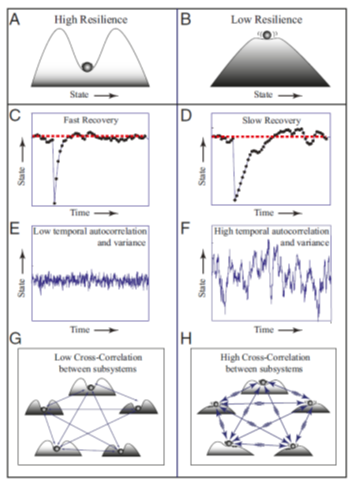
Structural coupling and synchronization occur in human dynamics in many ways, including the coordination between conversation partners. This might be one of the best settings for a study of human dynamics as synchronization occurs at multiple intermingled levels: linguistic (Orsucci 2006), motor (Repp und Su 2013) and physiological (Glass 2001).
Mapping complexity

With our current theoretical knowledge and technology of time series analysis we find that besides the possibly periodic and noisy oscillations (a) there are other mainly deterministic and stochastic areas. The common routes to chaos (c) and (d) and extensions for small nonlinearity (b) or small noise (e). Then there are a few islands (f) like hidden Markov models and a few others where a connection between nonlinear stochastic model approach and real-world phenomena can be made.
Harmony and Noise
•Sympathetic resonance or sympathetic vibration is a harmonic phenomenon wherein a formerly passive string or vibratory body responds to external vibrations to which it has a harmonic likeness. •Stochastic resonance occurs when an optimal level of noise is added to a subthreshold signal. In this example the signal alone (sinusoid) remains below the perceptual threshold (dotted line). Adding an optimal amount of noise (gray line) periodically raises the stimulus above the system threshold. If the added noise is too weak, the threshold is not crossed. Conversely, if the noise is too strong the signal remains buried and cannot be discriminated from the noise.

Chimera Sphinx States
•Resonance and synchronization can generate dynamical landscapes of mixed so-called Chimera Sphynx states where we might find areas of synchronization, areas of resonance and areas incoherently drifting away from these coupling phenomena. Kuramoto and Battogtokh (2002 Nonlinear Phenom. Complex Syst. 5 380) discovered chimera states represented by stable coexisting synchrony and asynchrony domains in a lattice of coupled oscillators.

Systemic Resilience
•Many complex systems can be seen as networks of subsystems, and organisms are no exception.
The capacity to bounce back from challenges implies a capacity to avoid a cascading collapse that brings the entire network down.
It has been shown that in networks in which the elements depend on each other (facilitative networks), a rising correlation between the fluctuation in the time series of different elements may indicate the risk of such a systemic collapse
Interactive dynamics of subsystems (e.g., mood, posture, cognition) are predicted to become more correlated in a network with low systemic resilience.

Quantum Choruses
Human interactions are essentially based on hybrid synchronization dynamics of embodied communication. They are also essentially intermittent and punctuated by discontinuities, from steps in conversations, to meetings etc. Time series are coarse grained and discontinuous. Also, synchronization can vary from initial entrainments, chimera states to phase transitions into full merger synchronization (similar to plasma or Bose condensate). The continuity of time series in human dynamics should be reconsidered in favor of a quantum field approach based on the following principles.

Relational Quantum Mechanics
Relational quantum mechanics (RQM) is an interpretation of quantum mechanics which treats the state of a quantum system as being observer-dependent, that is, the state is the relation between the observer and the system. This interpretation was first delineated by Carlo Rovelli in a 1994 preprint, and has since been expanded upon by a number of theorists. It is inspired by the key idea behind special relativity, that the details of an observation depend on the reference frame of the observer, and uses some ideas from Wheeler on quantum information.
The difference with classical mechanics is that (a) variables
take value only at interactions and (b) the values they take are only
relative to the (other) system affected by the interaction. Here “relative”
is in the same sense in which velocity is a property of a system relative
to another system in classical mechanics. The world is therefore
described by RQM as an evolving network of sparse relative events,
described by punctual relative values of physical variables.
1. Granularity: Reality is a network of granular events; the dynamic which connects them is probabilistic; between one event and another, space, time, matter and energy melt in a cloud of probability
2. Relationality, in space and time
3. Indeterminacy. The theory also gives information on which value of the spectrum will manifest itself in the next interaction, but only in the form of probabilities.

Resilient Complexities
•The emergence of DIORs (dynamical indicators of resilience) clarifies how systemic capacity, robustness and resilience rely on heterogeneous networks where correlation is in place, but it is within a wide range of resonance capabilities. •Chimera/Sphinx states are crucial to recognise dynamic indicators of resilience.
